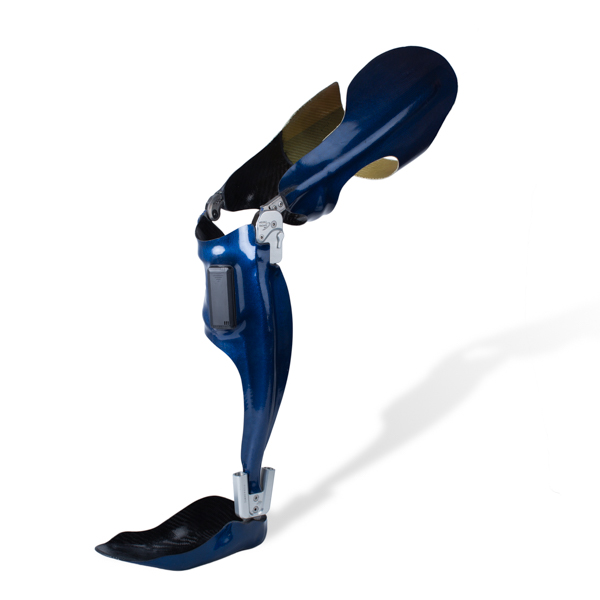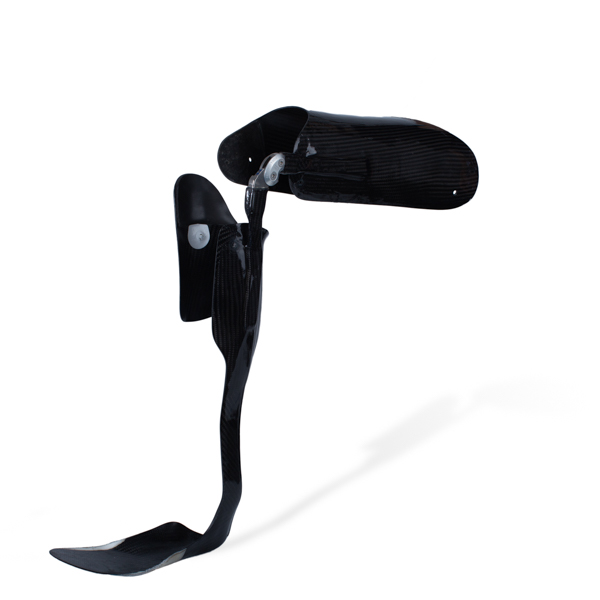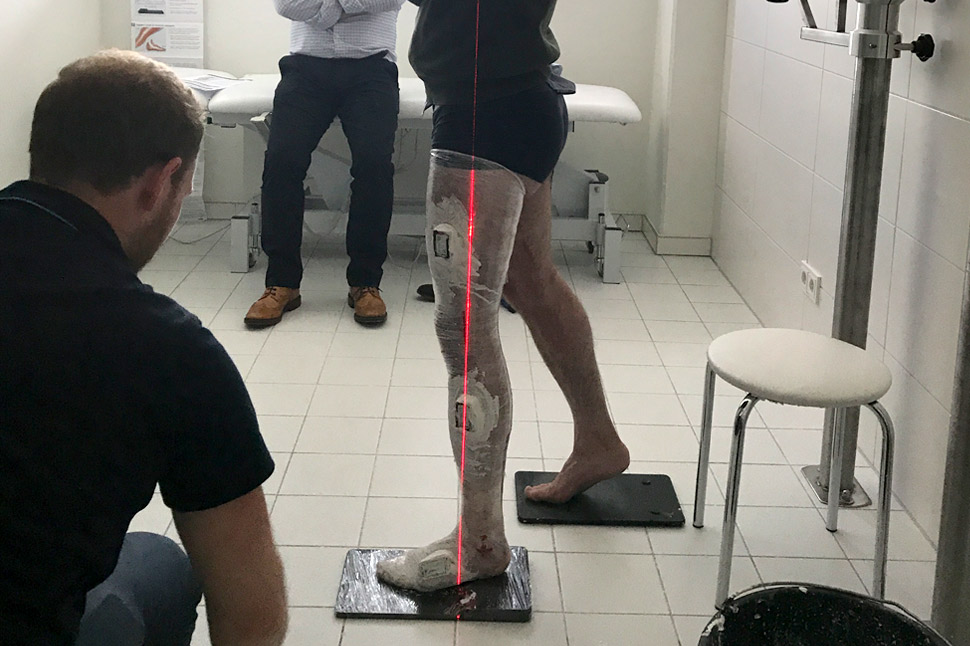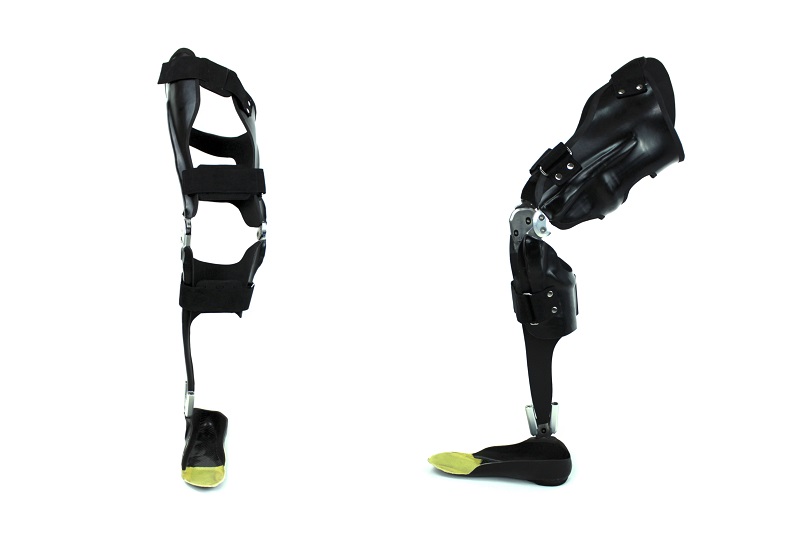A Knee Ankle Foot Orthosis, or KAFO, is an entire leg orthosis that spans the knee, ankle and foot. It is prescribed to assist and stabilise the muscles of the leg, particularly for patients with muscle-weakening conditions or paralysis. The most common causes of muscle weakness are post-polio syndrome, muscular dystrophy, multiple sclerosis and spinal cord injury. KAFOs work to:
It is best advised to choose supportive, comfortable shoes to wear with your KAFO to make the most of the benefits.
Until recently the only KAFO that was available was fixed with a locking knee joint. While they provide the needed stability to the knee, it can lead to muscle atrophy (muscle wastage through inactivity). Other disadvantages include unnecessary energy expenditure and a non-cosmetic walk.
Recently, Free Walk stance control orthoses have become available which can automatically lock and unlock at the right time in the gait cycle. These are lightweight and allow for a more natural gait while ensuring that leg muscles are also still being used.

Carbon Fibre KAFO – incredibly strong yet lightweight to help reduce energy expenditure. The reduced bulk also means it can fit within a wider range of shoes.
Otto Bock E-MAG Active KAFO – lower limb orthosis which electromagnetically locks and unlocks the knee during the gait cycle.
Neuro HiTronic Knee System - state-of-the-art orthosis technology developed in Germany with stance phase protection and microhydraulics.
One of our specialised orthotists will be able to advise on the KAFO best suited to your needs and preference. Give us a call or drop us an email to book a consultation today.

Unlike traditional KAFOs with their locked leg brace, “stance control” KAFOs allow the wearer to walk far more naturally. The brace locks and unlocks at just the right time; so it is locked while standing but allows the knee to be in free motion during the swing phase of normal walking.
The London Orthotic Consultancy has recently become accredited to start manufacturing in-house bespoke KAFOs using technology developed by leading orthopaedic technology company Fior & Gentz in Germany. They are created using joint sensors connected to a microprocessor which can lock and unlock the joint depending on which stage of the gait cycle the wearer is in. For example, when the wearer’s leg is lifted off the ground and swinging in the air – swing phase – it needs to be unlocked. Similarly, when a person is standing on the leg – stance phase – the joint needs to be mechanically stable and is locked into position.

The neuro-tronic system knee joint is controlled electromechanically either by a pressure sensor under the foot of the orthosis or by motion sensors integrated into the controller.
These KAFOs are made from direct-milled titanium and have one joint instead of the conventional two on either side. They are lighter, intuitive and smooth out the gait cycle to create a more natural walk.
Clinicians at LOC are now fully accredited to carry out Fior & Gentz methods of neuro-tronic KAFO production. Your orthotist will talk you through the best solution for your specific condition and your personal needs and preference.
LOC technician Simon and orthotists David and Sam underwent their three-day training workshop with Fior & Gentz. You can read about their trip to Luneberg, Germany in our news post.
If you think you might benefit from our new KAFO technology and our bespoke in-house service, give us a call or drop us an email to book a consultation today.

We have the following facilities and amenities at our Kingston Upon Thames location:
We also have the Gait Laboratory for orthotics patients and Onsite Manufacturing for speedy turnarounds and adjustments whilst you wait.
An insole is a contoured orthotic device which alters the characteristics and biomechanics of the foot and ankle area. Biomechanics are concerned with mechanical laws and how they affect the living body, especially the musculoskeletal system.
They are removable devices, often made from plastic, that are designed to fit inside a shoe to provide additional support for your feet. As well as offering shock absorption, an insole can help distribute the weight of your body more effectively across the foot and can be made bespoke to cover a range of biomechanical conditions.
If you have symptoms in your feet, ankles, hips or your lower back that are intermittent or were not there to start with in early life, and have started to cause you pain over a period of time, bespoke orthotic insoles could be an excellent option.
If you have already tried rest, icing, compression and elevation and your feet have not recovered, we recommend a biomechanical assessment to consider the possibility of insoles. They are a non-invasive approach to treatment and in many cases, are a great option for symptoms that are not severe enough to warrant surgical intervention. Alternatively, they can be considered as an option prior to surgery.
We will send patients away when an insole is not appropriate, if a patient is suffering with iliotibial band syndrome for example, the problem can be helped with physiotherapy and a stretching programme. That’s what our biomechanical assessment is all about; determining whether there would be any benefit from altering the alignment of your feet.

See how a thorough gait analysis and a correctly-fitted, bespoke Reciprocating Gait Orthosis (RGO) helped Ted, a spinal surgery and cancer survivor, improve his rehabilitation and mobility goals, getting him back on his feet again.

We are proud to announce the launch of our latest innovation in non-surgical treatment for pectus deformities. Our new dynamic chest compressor is one of the slimmest pectus braces on the market and is designed to reshape the chest without the need for invasive surgery.

Rosie’s very severe plagiocephaly was no problem for the LOCBand Lite 3D-printed cranial remoulding helmet, going from 16mm to 2mm in just six months.

When John came to see us, his ankle was in a bad way. He had around 60mm of his tibia missing and not much if any talus present. He needed crutches to support him to walk. A gait analysis and a new bespoke carbon fibre knee ankle foot orthosis (KAFO) later and he is able to walk again without crutches.

Matilde travelled from Chile to LOC for bracing treatment for her adolescent idiopathic scoliosis. Now, nearly a year and a half since she started wearing her brace, she has achieved near-total correction of the curvature of her spine. This is her scoliosis bracing story.

After only 6 months of wearing bespoke pectus braces from The London Orthotic Consultancy, Will started to notice a visible difference in his pectus carinatum.

After trying out several scoliosis braces in Romania, Ukraine and Turkey, Iulia begins treatment with the LOC Scoliosis Brace and is already seeing results in a matter of months. Here her mum, Raluca, describes how and why they came to LOC for her treatment.

Through bracing treatment with the dynamic chest compressor, Jack has achieved 90% correction in his pectus carinatum after only two months. Here, mum describes Jack's non-surgical treatment journey.